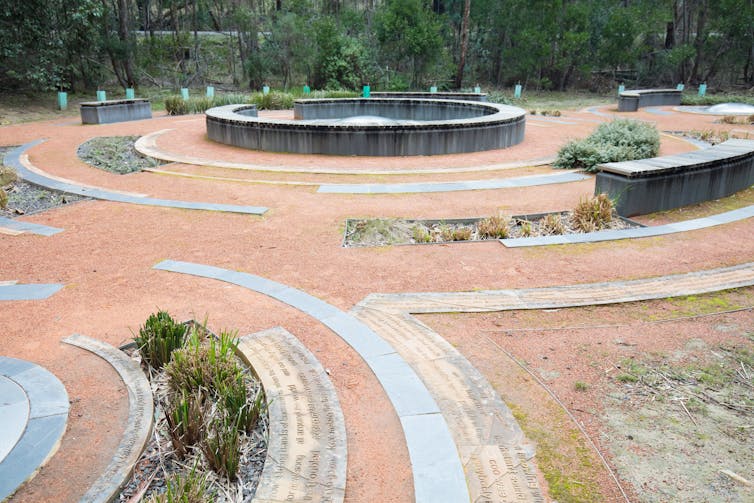Artists are again finding themselves at the receiving end of criticism over funding.
A mural on the wall of a fire station funded through the Western Australia Percent for Art scheme has met with a hostile reaction in the light of the bushfire crisis.
In WA all new public buildings costing $2 million or more must spend 1% of the building costs on public art projects – a bipartisan initiative since 1989.
Public art plays an important role in connecting communities, humanising the environment and giving a community a unique identity, but WA Shadow Minister for Emergency Services Steve Thomas told the ABC “I think it is time for this policy to end”
“[It] is more important to put that money into the equipment [emergency services] require rather than art work to decorate the building,” he said.
Artists are a critical community resource, but this criticism is a familiar refrain in Australia where arts practice is seen as non-essential.
The federal government determined in December 2019 the arts no longer matter to the nation by disappearing the arts from mention as a governmental responsibility and continuing to cut arts funding.
Read more: Remember the arts? Departments and budgets disappear as politics backs culture into a dead end
Crucial fundraisers
Across the country, the average income of artists from their artwork is A$18,800, yet artists have raised millions of dollars in support of the 2020 bushfire crisis.
Comedian Celeste Barber has raised over $50 million from more than 1.2 million people to help those who need it.
Pink, Elton John, Metallica, Nicole Kidman and Keith Urban, Chris Hemsworth, Kylie and Danni Minogue – to name only a handful – have personally donated large amounts of their own money to help fighters and victims.
Visual artist Scott Marsh raised more than $60,000 by painting a mural in Chippendale lampooning Scott Morrison.
The Stardust Circus prevented a blackout at the Ulladulla Evacuation Centre by lending their generator. Theatre companies are organising collections at their performances for bushfire relief.
More than 32 concerts are taking place across the country with musicians giving their time for free to fundraise. Visual artists are auctioning their work.
Writers, illustrators and editors are donating books, mentoring, and naming rights to characters in forthcoming books to support firefighters.
As one viral Facebook post asked: “Tell me again that the Arts have no value?”
Restoring hope
Silo art, the painting of water towers and other utilitarian sites such as fire stations, have transformed rural areas by the impact of arts practice. This has contributed to the economic well-being of these communities, as well as making the local community feel a sense of pride in their town.
Art and artists can have a transformational role in rural communities by building resilience. Rural communities value their local history and artists can play an essential role in recording and validating a community’s culture.
Arts institutions, such as regional galleries, can also have a dramatic impact on a community. In 2012, the Bendigo Art Gallery generated $16.3 million for the local economy. The Book Town festival in Clunes, the Writers Festival in Byron Bay and the Folk Festival in Port Fairy are all crucial to the sense of community in those towns.
Artists can be critical in restoring hope and providing healing to a community after it has experienced trauma.
The Creative Recovery Network works together with emergency management agencies across Australia to help communities affected by trauma and natural disasters to recover from their experiences.
Urban Initiatives and Arterial created a moving memorial in collaboration with the local community to the 2009 Black Saturday bushfire victims at Strathewen.
The memorial incorporates 10,000 words by community members and serves as a place for community reflection as well as an ongoing learning site for young people. In this way the experiences are never forgotten, and passed on to the next generation.
 The Black Saturday bushfire memorial at Strathewen.Shutterstock
The Black Saturday bushfire memorial at Strathewen.ShutterstockWhile the arts can create provocation, they can also be a means of honouring feelings and processing grief. There are times when communities need more than financial relief to recover from loss. They need a way to make sense of it so they can move forward.
Committed to their community
Artists have stepped up in a huge way at this dark time in Australian history by volunteering their talents and resources to support communities and firefighters.
They have demonstrated artists and arts practice can contribute to our society with passion, ingenuity, and imagination. It is time the arts and artists received the respect they deserve by our governments and the broader community.
The arts always matter, but at times of crisis they are especially valuable.
Jo Caust has received funding from the Australia Council. She is a member of the Arts Industry Council (SA) and NAVA.
Authors: Jo Caust, Associate Professor and Principal Fellow (Hon), University of Melbourne
| < Prev | Next > |
|---|







